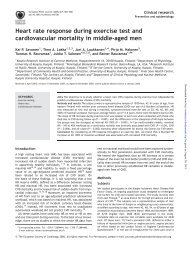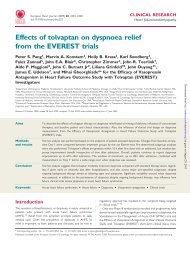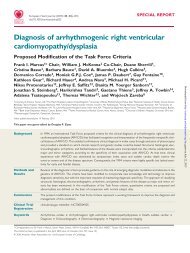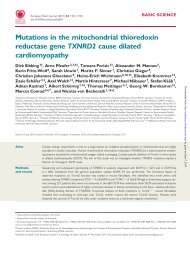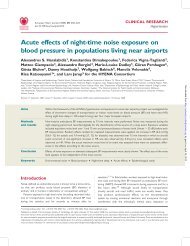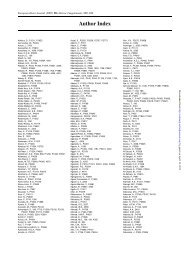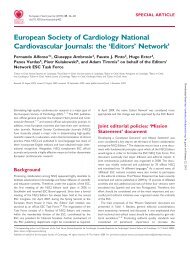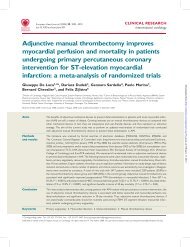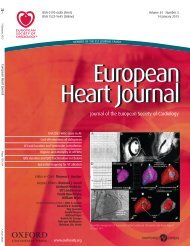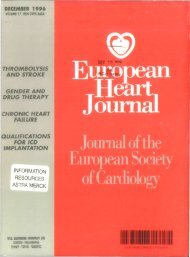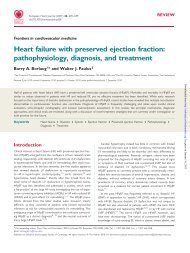Monday, 1 September 2008 - European Heart Journal
Monday, 1 September 2008 - European Heart Journal
Monday, 1 September 2008 - European Heart Journal
You also want an ePaper? Increase the reach of your titles
YUMPU automatically turns print PDFs into web optimized ePapers that Google loves.
266 Resuscitation resuscitated! / Risk assessment: strengths and weaknesses<br />
resuscitated from cardiac arrest and those without this complication. The higher<br />
mortality rate among resuscitated patients is explained by noncardiac complications.<br />
RISK ASSESSMENT:<br />
STRENGTHS AND WEAKNESSES<br />
1762 Aortic augmentation index: reference values and<br />
association with known cardiovascular risk factors in a<br />
Danish population<br />
J.H. Janner1 , N.S. Godtfredsen2 , P. Lange1 ,J.Vestbo1 ,E.Prescott2 .<br />
1Hvidovre University Hospital, Cardiology and Respiratory Medicine,<br />
Copenhagen, Denmark; 2Bispebjerg University Hospital, Department of<br />
Respiratory Medicine, Copenhagen, Denmark<br />
Background: It has been proposed that aortic augmentation index (AIx) – a measure<br />
of arterial wave reflection – can be used as a surrogate measure of arterial<br />
stiffness. In a selected patient group (end stage renal disease) AIx has been<br />
shown to be a predictor of all-cause mortality. AIx has also been shown to predict<br />
cardiovascular events in patients with hypertension and patients undergoing PCI.<br />
Studies of reference values of AIx are scarce.<br />
Objective: 1) To report reference values of AIx in a population at low risk of CVD<br />
according to <strong>Heart</strong>score. 2) To investigate the association between AIx and known<br />
CVD risk factors in a large cohort of the Danish population.<br />
Methods: This population-study is based on 4700 subjects from the Copenhagen<br />
City <strong>Heart</strong> Study. In those with the lowest risk of CVD as defined by <strong>Heart</strong>score<br />
we analysed AIx adjusted for heart-rate and its dependency of sex, age and<br />
height using linear regression. Multivariate linear regression was used to examine<br />
the association between AIx and the following risk factors for CVD – systolic<br />
and diastolic blood pressure, total-cholesterol, LDL cholesterol, HDL cholesterol,<br />
triglycerides, high-sensitive C-reactive protein (hs-CRP), smoking status, years of<br />
smoking, alcohol consumption, diabetes, medication for hypertension, heart disease<br />
or high cholesterol, physical inactivity, familiar history of CVD and education.<br />
All analyses were stratified by sex.<br />
Results: AIx was positively associated with age and negatively with height in<br />
those with lowest risk of CVD in the following manner: Woman: AIx = 26.56 +<br />
0.76 (age) – 0.004 (age 2 ) – 0.19 (height (cm)). Men: AIx = 59.52 + 0.42 (age)<br />
– 0.38 (height (cm)). We found increasing AIx with increasing risk of CVD as<br />
defined by the <strong>Heart</strong>score index. In the multivariate analyses AIx was positively<br />
associated with systolic and diastolic blood pressure, hs-CRP and current smoking<br />
and – negatively with weight for both sexes, and positively associated with<br />
total cholesterol for men only. AIx was not associated with other CVD risk factors,<br />
including diabetes.<br />
Conclusions: We propose a novel equation including age, height and sex to<br />
calculate reference values for AIx - based on a large general population sample<br />
with low risk of CVD. AIx is highly dependent on age and both systolic and<br />
diastolic blood pressure, positively associated with hs-CRP and current smoking.<br />
This study is the largest to date evaluating the association between AIx and<br />
known CVD risk factors. We plan to examine AIx as independent predictor for cardiovascular<br />
events and mortality in the Copenhagen City <strong>Heart</strong> Study – a cohort<br />
with low risk of CVD.<br />
1763 Increased cardiovascular mortality in women with<br />
normal weight obesity<br />
A. Romero-Corral1 , V.K. Somers1 , S. Boarin 2 , J. Sierra-Johnson3 ,<br />
Y. Korenfeld4 , J. Korinek4 , G. Parati 5 , F. Lopez-Jimenez1 . 1Mayo Clinic, Cardiovascular, Rochester, United States of America; 2Mayo Clinic and Istituto Auxologico Italiano, Cardiovascular, Milan, Italy; 3Mayo Clinic<br />
and Karolinska Institute, Cardiovascular, Stockholm, Sweden; 4Mayo Clinic,<br />
Cardiovascular, Rochester, United States of America; 5Istituto Auxologico<br />
Italiano, Cardiovascular, Milan, Italy<br />
Background: We hypothesized that subjects with normal weight obesity (NWO),<br />
defined as those with normal BMI but high body fat (BF) content, in whom we<br />
have previously reported a higher prevalence of metabolic syndrome and cardiovascular<br />
(CV) risk factors, are at higher risk for total and CV mortality.<br />
Methods: We analyzed 2,127 subjects ≥ 20 years of age from the Third National<br />
Health and Nutrition Examination Survey (NHANES III) and mortality study with<br />
normal BMI (18.5-24.9 kg/m 2 ), body composition assessment, fasting morning<br />
blood measurements and CV risk factors data. Survival information was available<br />
for all subjects after 8.7 years of follow-up. We divided our sample into three<br />
groups: low BF (35% in women), defined as NWO. We compared total and<br />
CV mortality across groups.<br />
Results: NWO comprised ∼20% of all subjects with a normal BMI. Table displays<br />
the total and CV mortality rate in men and women according to BF. As BF<br />
increased in men, there was a non-significant increased risk for total and CV mortality.<br />
However, as BF increased in women, there was a significant increased risk<br />
for total and CV mortality. When compared to the low BF group, NWO women<br />
showed a trend towards higher total mortality (HR=1.52; 95%CI, 0.83-2.77), and<br />
after adjustment for age, dyslipidemia, hypertension, diabetes, CV disease and<br />
Total and cardiovascular deaths by BF<br />
Men (n=1,1036) Body fat 25% Age and race adjusted<br />
(n=378) (n=400) (n=248) p-value for trend<br />
Total deaths 39 (5.63%) 42 (6.36%) 37 (12.5%) 0.21<br />
Cardiovascular deaths 15 (2.52%) 20 (2.63%) 13 (4.94%) 0.59 †<br />
Women (n=1,101) Body fat 35%<br />
(n=428) (n=427) (n=246)<br />
Total deaths 20 (3.03%) 31 (5.55%) 22 (8.25%) 0.038<br />
Cardiovascular deaths 5 (0.87%) 12 (2.12%) 12 (4.37%)* 0.044 †<br />
*p-value



